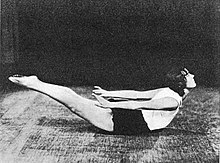Yoga in Britain
In the 1930s, instructors such as Mary Bagot Stack taught postures similar to several modern asanas to women in Britain between the world wars, but these were not then described as yoga.The 1968 visit of the rock music group The Beatles to Maharishi Mahesh Yogi's ashram in India drove counter-cultural interest in yoga.John Ovington in his A Voyage to Suratt, In the Year, 1689[2] described them as "holy mendicants" who had a "sordid aspect";[a] he attributed their taking solemn vows to remain in strange postures all their lives as "Delusions of Satan".[4] Similarly, John Fryer in his 1698 A New Account of East-India and Persia[5] recorded a "Jougie" who had a gold ring in his "Virile Member" to keep him from sexual activity, and wrote of ascetics who held postures until their limbs withered; he called such people "Vagabonds" who pretended to be pious.[b] He helped to link yoga in the mind of the British public with magic, yogis with fakirs, and tantra with "Western esoteric sexual practices".[9] In July 1935, the magazine featured Adonia Wallace demonstrating the "Exercises Which Gave Me Fame"[10] as "The Girl with the Perfect Figure",[10] with the poses now called Rajakapotasana, Urdhva Dhanurasana, Natarajasana, and Eka Pada Viparita Dandasana.She trained as a Franciscan nun but left the convent and then learnt "Pranayama Yoga" in Bombay, marrying another Indian Catholic, Roydon Cabral.[18] In 1968, the rock music group The Beatles led counter-cultural interest, travelling to India and practising Transcendental Meditation with the Maharishi Mahesh Yogi in his ashram at the "yoga capital of the world",[19] Rishikesh.Newcombe speculates that their husbands may have found having their wives attending "course on traditionally feminine subjects like flower arranging or cooking ... less threatening and more respectable than employment outside the home.[25] Adult education funding was cut sharply in the 1980s when Margaret Thatcher was prime minister, and yoga moved from public to private classes.The style, founded by K. Pattabhi Jois, made yoga into an aerobic exercise with continuous flowing movements, the asanas linked by vinyasa sequences based on Surya Namaskar, the salute to the sun.[38] Yoga in Britain is practised in varied settings and in many hybrid forms, from ashrams to village halls to prisons; with dogs, paddleboards, and aerially; for children and for those with Parkinson's; to awaken Kundalini, and as Christian "PraiseMoves".




B. K. S. Iyengar with yoga teacher Malcolm Strutt at Iyengar Centre House, London, 1971

Billy ChildishArdha PadmasanaMedway Poetsyoga as exerciseBritainasanasIyengar YogaAshtanga Vinyasa YogaoccultistAleister CrowleyMary Bagot StackSir Paul Dukesamong womenBritish Wheel of Yogayoga teacher trainingThe BeatlesMaharishi Mahesh Yogiashramcounter-culturalYoga for HealthInner London Education AuthoritySports Councilaerial yogaon paddleboardsSchool of Oriental and African StudiesAsceticsbanyanJean-Baptiste TavernierMark Singletonyoga practitionersvagrantslibertinesmendicantsJohn FryerJougieVirile MemberSalabhasanaRāja yogaMeenakshi TempleMaduraiPatanjaliYoga Sutrasdhyanaseventh stage on the path to enlightenmentfakirstantraTrikonasanaPaschimottanasanaRajakapotasanaUrdhva DhanurasanaNatarajasanaEka Pada Viparita DandasanaYoga for womenBirminghamPierre BernardNyack, New YorkShirshasanaadult educationWorkers' Educational Associationlocal education authoritySuzanne NewcombeBrahminBombayFranciscanchignonmodern yoga guruB. K. S. IyengarpranayamasB. K. S. IyengarLight on YogaSilva MehtaVisistadvaitaHinduismphysical educationtravelling to IndiaTranscendental MeditationRishikeshCrosby, on MerseysidePebble Mill at OneRichard HittlemanballerinaLyn MarshallfeminismOxfordMargaret Thatcher was prime ministerUK Sports Councilyoga teaching standardsK. Pattabhi Joisaerobic exercisevinyasaSurya NamaskarMaida Valemainly to womenvinyasasBikram YogaNorfolkprimary schoolattention deficit hyperactivity disorderautismNational Institute for Health and Care Excellenceobesityin many hybrid formsashramsvillage hallsprisonspaddleboardsaeriallyfor childrenParkinson'sKundaliniLake Districtring-tailed lemursJames MallinsonJason Birchscholar practitionersYoga in FranceYoga in GermanyYoga in ItalyYoga in RussiaYoga in SwedenYoga in the United StatesDavid Gordon WhiteSanyasisworking classFryer, JohnNewcombe, Suzanne